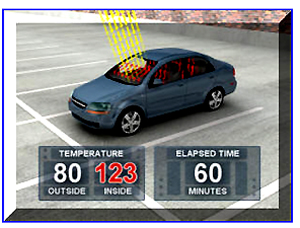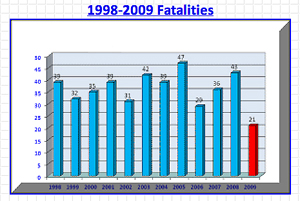
| CONNECTIONS |
IDAHO
ITD
HOME
511 TRAVEL SERVICES
IDAHO
DMV
ITD
NEWS
HIGHWAY
SAFETY
IDAHO STATE POLICE
STATE OF IDAHO
NIATT
NATIONAL
AASHTO
AAMVA
AAA of IDAHO
FEDERAL HIGHWAYS
FEDERAL AVIATION
IDAHO STATE POLICE
NHTSA
NTSB
TRB
U.S. DOT
TRANSPORTER
Archives
Milestones
Comments
Idaho
Transportation
Department
Office of Communications
P.O. Box 7129
Boise, ID 83707
208.334.8005
Fax: 208.334.8563


Rising temperatures turn cars into greenhouses –
never leave children unattended inside
Temperatures in southwest Idaho are expected to continue soaring past the century mark as we approach the hottest period of the summer. During these hot days, please take the following precautions to prevent child deaths:
|
There’s little debate – cars and alcohol can be deadly combinations. Add extreme heat as another contributor to fatalities.
Anytime ambient, outdoor temperatures reach the 80s, inside car temperatures can rapidly rise to more than 100 degrees, proving lethal to children and pets that have been left inside with no relief.
Each summer a number of infants and young children tragically die in vehicles after being left by caregivers and parents who plan to be gone only a few minutes. Cars assume the characteristics of a greenhouse where air is trapped without ventilation and temperatures rise quickly.
Thus far in 2009, hyperthermia has claimed the lives of 21 children who were left unattended in cars. That’s about half the number (43) who succumbed to heat-related deaths from vehicles last year. The average since 1998 is 37 per year.
A study of heat-related deaths to young children from 1998 to 2007 indicated that 52 percent of the victims were “forgotten” by their caregiver; 30 percent of the children had been playing in an unattended vehicle; 17 percent were intentionally left in a vehicle by an adult, and circumstances were unclear in 1 percent of the cases.
The average age of a car-related hyperthermia death is 24 months; 22 percent of the victims were one year old; 21 percent were two years of age.
Hyperthermia is an acute condition in which the body produces or absorbs more heat than it can dissipate, usually through excessive exposure to heat. Among those who work or exercise in extremely high temperatures, hyperthermia is manifested in heat stroke or sunstroke.
“Sunlight can heat car interiors to lethal temperatures in just 30 minutes, even if the weather is relatively cool,” according to NewScientist. “Researchers strongly urge parents not to leave children alone in parked cars, no matter how mild the weather.
“Even on relatively mild-temperature days, the internal temperature of a vehicle left in the sun quickly gets very warm – the average rise in one hour is 22 degrees Celsius,” explains researcher Catherine McLaren of Stanford University. “My guess is that parents would be surprised that leaving children in a car is very much like leaving them in a sauna.”
A 2002 study tracked the changes of inside air temperatures of a dark blue, midsize sedan with a medium gray interior.
 Temperatures on 16 random summer days ranged between 72 and 96 degrees. Inside the test vehicle, the temperature rose an average of 19 degrees in 10 minutes, 29 degrees in 20 minutes, 34 degrees in 30 minutes and 43 degrees in an hour. Leaving the window down slightly produced little relief. Vehicle interior colors appear to be a major factor in how rapidly automobile temperatures rise.
Temperatures on 16 random summer days ranged between 72 and 96 degrees. Inside the test vehicle, the temperature rose an average of 19 degrees in 10 minutes, 29 degrees in 20 minutes, 34 degrees in 30 minutes and 43 degrees in an hour. Leaving the window down slightly produced little relief. Vehicle interior colors appear to be a major factor in how rapidly automobile temperatures rise.
In a 90-degree environment, it takes less than 20 minutes for the inside of a car to reach 125 degrees. In less than 40 minutes, the inside temperature can soar to 140 degrees.
“Young children and infants are much more susceptible to heat illnesses than adults,” according to authors of the study. “…Toddlers’ body temperatures rise faster and they lose proportionally more water than adults in hot weather.”
Temperatures do not need to reach triple digits to pose life-threatening conditions for children. Symptoms include lethargy, dehydration, vomiting, diarrhea and a body temperature of up to 104 degrees, according to the Texas Children’s Hospital. Children lose their ability to sweat, resulting in seizures, stroke and ultimately death.
Published 7-24-09